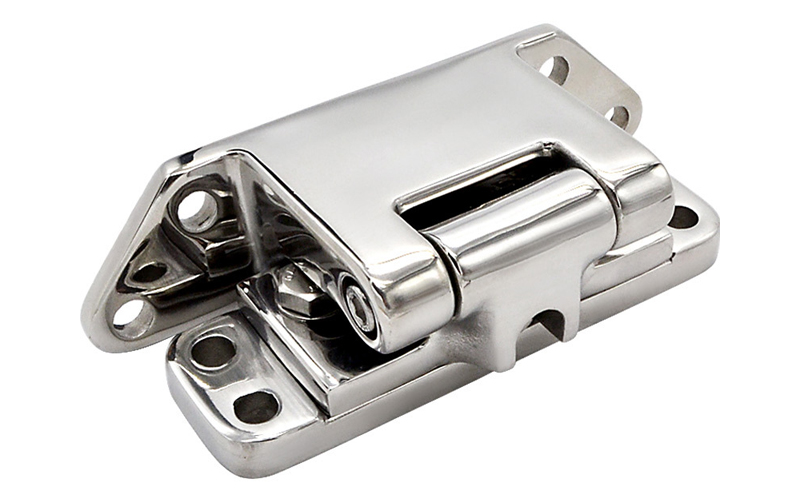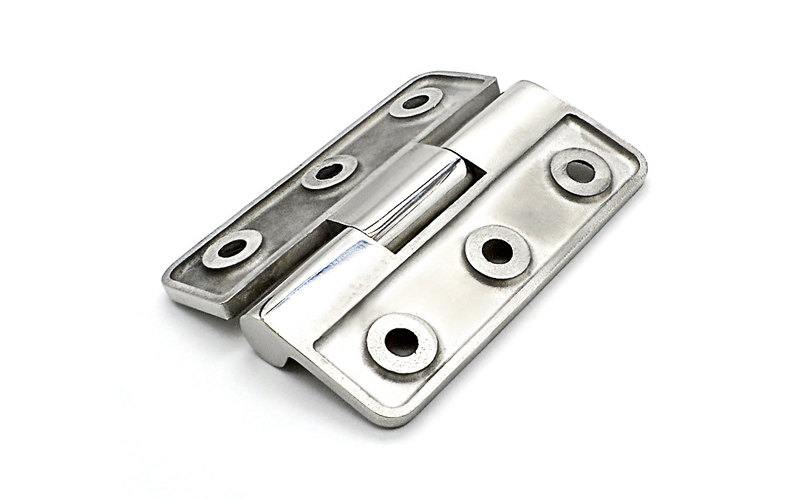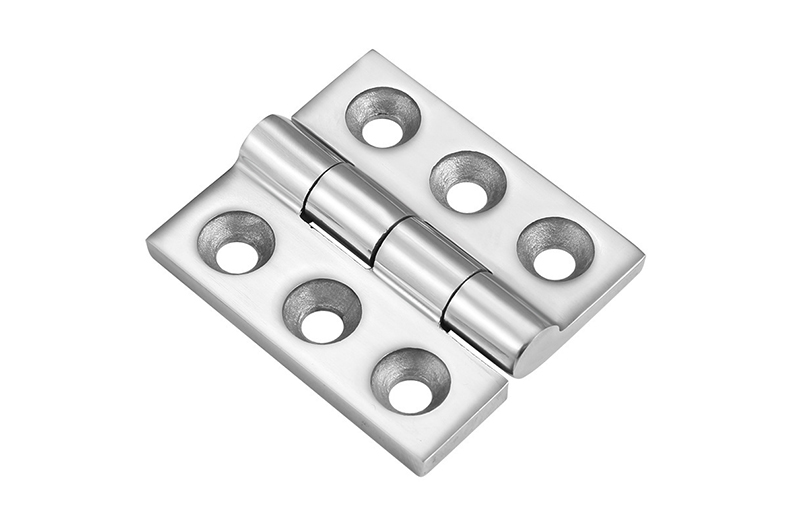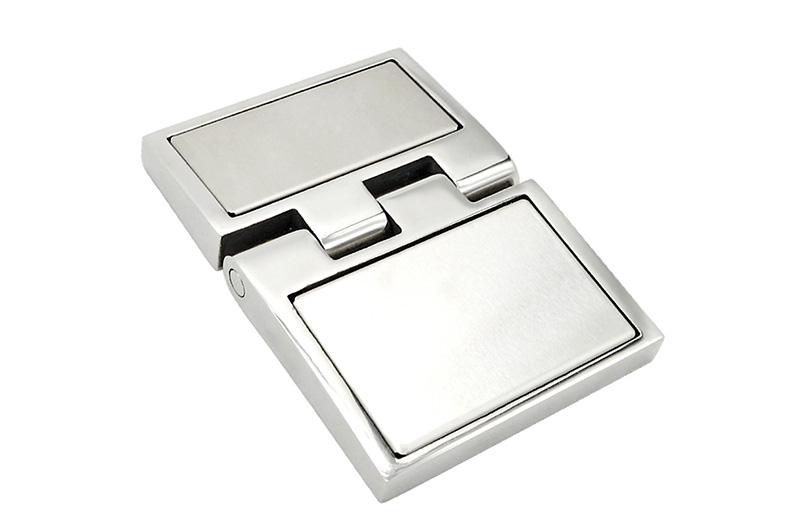One way to name hinges is by their material. For example, stainless steel hinges, zinc alloy hinges, and plastic hinges. This is a way of naming hinges that highlights their material
This is a way to highlight the material. This way is often used to highlight the characteristics of the hinge. In today’s article, I would like to focus on stainless steel heavy-duty hinges.
It is a type of hinge that is often used in industrial equipment and sheet metal box equipment, especially for doors of heavy equipment. Of course, this kind of hinge is not cheap, which is due to its material
and production process. I will introduce it in detail from the following 7 aspects.

What is a stainless steel heavy-duty hinge?
The so-called stainless steel heavy-duty hinges are mainly a class of industrial heavy-duty hinges made of stainless steel. It is a very good performance material with good corrosion resistance
Corrosion performance and strength, in various fields of use, are very wide. It can be used both indoors and outdoors. Especially outdoors can show the excellent performance of this material.
It can be used both indoors and outdoors. Because it can occur a redox reaction so that it is not corroded and rust.
Stainless steel heavy-duty hinges are made of stainless steel for every component, including the hinge core. Stainless steel heavy-duty hinges can be found in both the commercial and industrial sectors.
Heavy-duty hinges can be found in both commercial and industrial applications. These hinges have a much greater load-bearing capacity than other materials such as zinc alloy.
What are the characteristics of stainless steel heavy-duty hinges?
-
No rusting
Stainless steel is an alloy composed of several elements. One of these elements is chromium, which forms a passivated film on the surface after an oxidation reaction. And inside the stainless steel, the content of chromium is more than 12% so naturally, the iron or steel will not be exposed to oxygen. Iron or steel will not rust if it is not exposed to oxygen.
Therefore, stainless steel hinges can be used in harsh outdoor environments.
-
High Strength
The strength of stainless steel hinges is higher than that of zinc alloy hinges or other materials. And it has a certain toughness and a high yield degree. So this material of hinges can withstand the effect of force for a long time. Ideal for doors with heavy equipment.
-
Corrosion resistance
Ordinary carbon steel comes into contact with oxygen in the atmosphere and forms an oxide film on the metal surface. The oxidation then continues, causing the corrosion to expand. Formation of “lasagna” type corrosion
-
Until complete rust
Stainless steel and chromium content in the light. When the chromium content of steel reaches 12%, contact with the atmosphere, the surface of stainless steel produces a passivation film (Cr203). Dense chromium-rich oxide effectively protects the surface of stainless steel.
In particular, it prevents further reoxidation. This oxide film is extremely thin only a few microns, through which can be seen the natural luster of the steel surface. This gives stainless steel its unique surface. If the surface passivation film is once destroyed, the chromium in the steel and atmospheric oxygen generate passivation film, continuing to protect.
-
Non-magnetic
Stainless steel heavy-duty hinges are non-magnetic. It can be used on special occasions. For example, various equipment in the field of new energy requires hardware that is not magnetic. This non-magnetic magnetism is also determined by the material.
-
No need to do surface treatment
We already know the principle of corrosion resistance of stainless steel. Naturally, we can understand why surface treatment is not necessary. This is because, after the oxidation reaction, the material can continue to do the reduction reaction. The surface re-formation of a protective film.

Material details of stainless steel heavy-duty hinges
The corrosion resistance of stainless steel material decreases with the increase in carbon content. Therefore, the carbon content of most stainless steels is low, with a maximum of no more than 1.2%. Some steels have a carbon content of even less than 0.03%.
The main alloying element in stainless steel is Cr (chromium), only when the Cr content reaches a certain value, the steel has corrosion resistance. Therefore, stainless steel generally Cr (chromium) content of at least 10.5%. It also contains Ni, Ti, Mn, N, Nb, Mo, Si, Cu, and other elements.
Stainless steel hinges versus zinc alloy hinges
Stainless steel hinges have a very fine, very shiny surface. Zinc alloy, on the other hand, has a very weak luster and often requires a surface treatment on its surface. It is because the surface of zinc alloy material the lack of luster can make the plating layer or paint can be well attached to its surface and not easy to fall off.
The hardness of stainless steel hinges is much higher than that of zinc alloy hinges. However, zinc alloy hinges can have more complex structural designs and are particularly suitable for pressure casting. The more complex hinges and locks are seen on the market
The more complex hinges, locks, and other hardware products seen on the market are almost all made of zinc alloy.

Do I choose stainless steel or zinc alloy for the hinge material?
The choice of which material to use is based on the weight of our equipment doors. If it is an ordinary sheet metal box door, you can consider using zinc alloy material. If it is a more heavy-duty equipment door, stainless steel is required. Or, if the hinges are made of zinc alloy, you need to make sure you can meet the load-bearing requirements.
We have developed and produced a wide range of heavy-duty oven hinges made of zinc alloy in the industrial oven sector. These hinges are made of zinc alloy and have been proven for extensive practical use.
The reliability of these hinges has been proven in a large number of practical applications.
How can I be sure that the hinges are really made of stainless steel?
If you are sure that the stainless steel heavy-duty hinges you buy are really made of stainless steel. There are a variety of stainless steel materials, the most common being 201, 301, and 304.
There are various ways to determine the quality of stainless steel, some reliable, some not. In the following, I produce a brief introduction.
-
Magnet
This method uses a magnet to suck the product, sucked is “stainless steel”, and can not be sucked “stainless steel”. This method seems to be very scientific, and popular is also very wide. In fact, this method is not scientific.
-
Stainless steel test solution
The stainless steel test solution identification method is to determine or distinguish some of the measured steel by observing the color change characteristics of the test solution in the process of dissolving the measured steel. The situation. The color change is often related to the specific elements such as nickel (Ni), molybdenum (Mo), and manganese (Mn) in the measured steel.
But the use of stainless steel determination solution to identify stainless steel, only to a certain extent answers the question “not what grade”, and can not really answer the “what grade” problem.
-
X-ray fluorescence analysis method
X-ray fluorescence analysis is the application of an x-ray tube or radiation source emitted by the primary x-ray irradiation sample, when the sample is x-ray excitation, the excited electrons form the high-energy. When the sample is excited by x-rays, the excited electrons jump from the high energy level to the low energy level and emit characteristic x-rays.
X-ray analyzers can then form the characteristic x-rays of the exciting sample into an x-spectral map in a certain way. This allows qualitative and quantitative analysis of the sample to be measured. This method is fast, non-destructive, accurate, easy to operate, and reliable.

What are the uses of hinges?
This stainless steel hinge is mainly used in some places where the environment is harsh. For example, outdoor, or specific corrosive substances in the environment. In this harsh environment, stainless steel material can play its performance. If other materials are used for hinges, it is possible that they will be corroded or rusted in a short time.
Secondly, on the doors of some large equipment. The doors of such equipment are often very heavy and have a very high load-bearing performance. Even zinc alloy hinges can meet the requirements.
But considering the long-term use. There is a possibility that the zinc alloy material may lead to production fatigue, which may lead to hinge breakage. Therefore, for safety reasons, stainless steel hinges are used.




